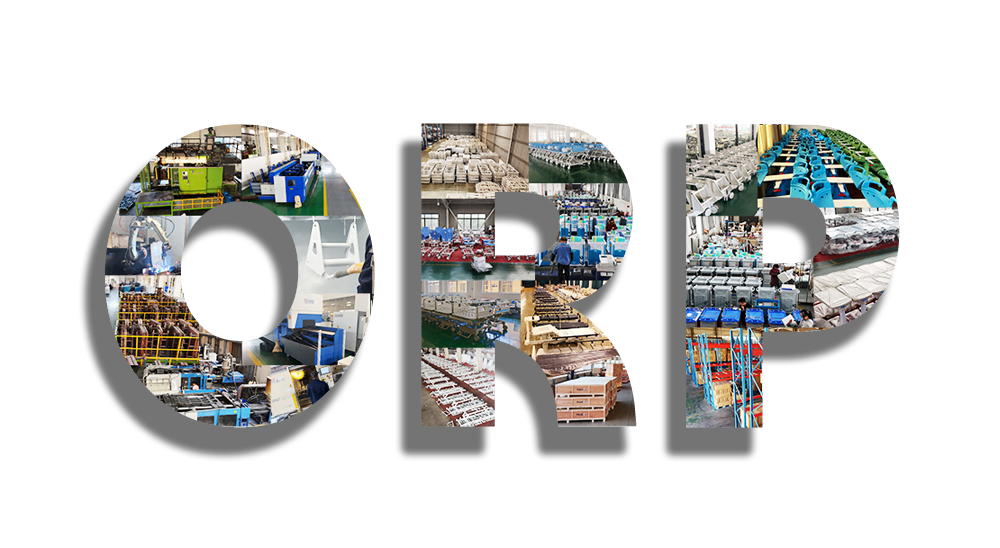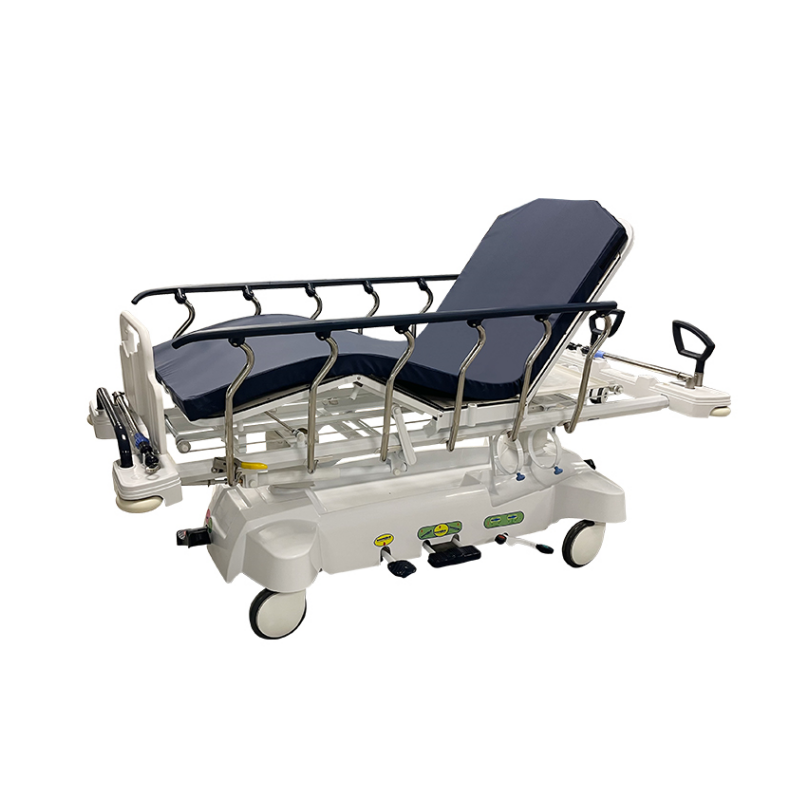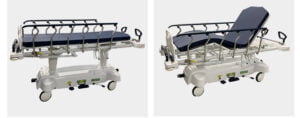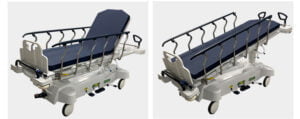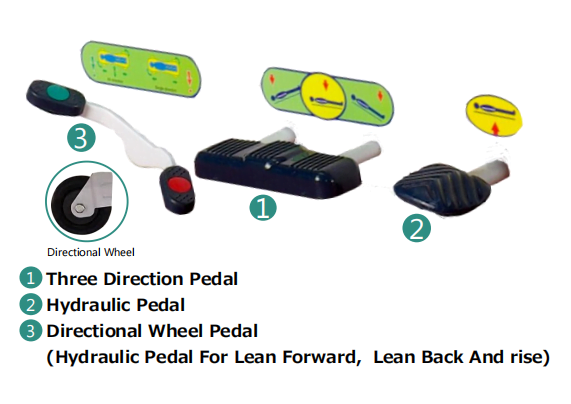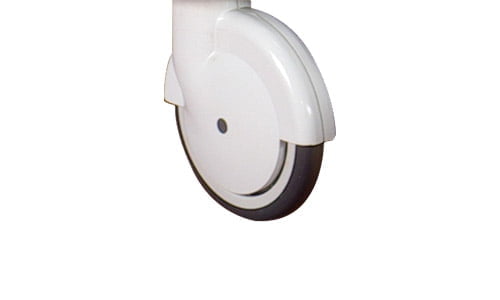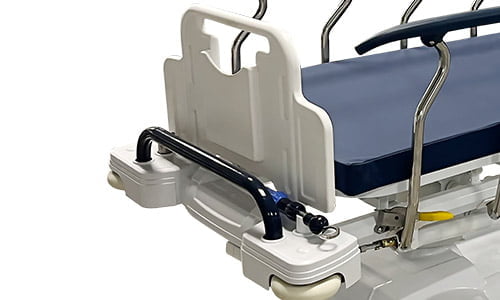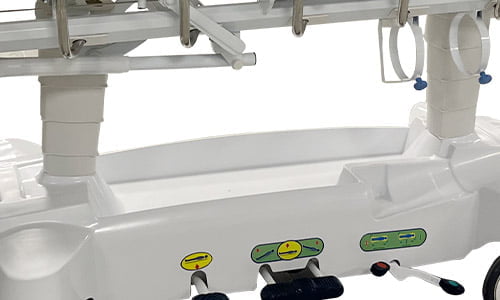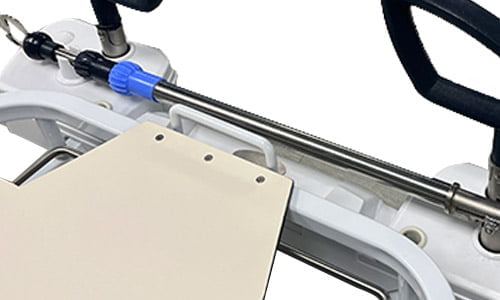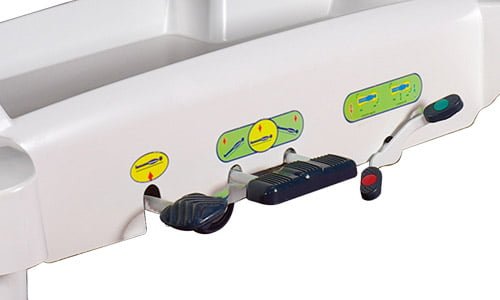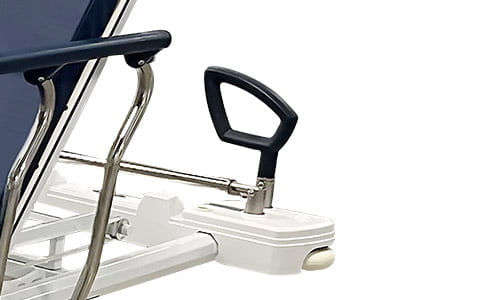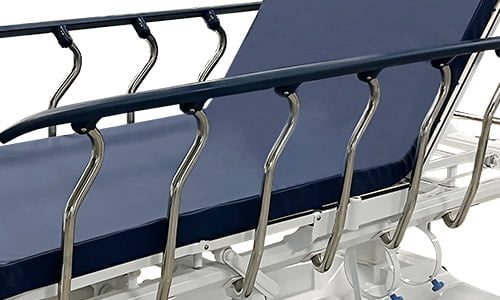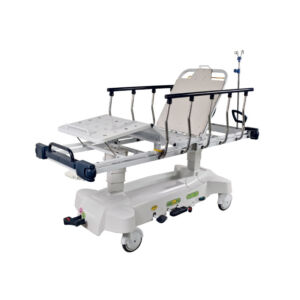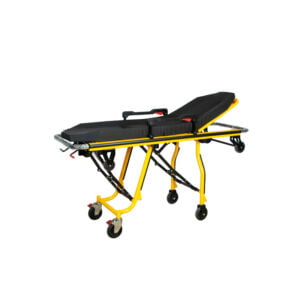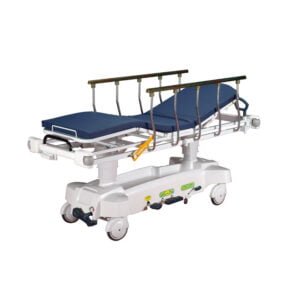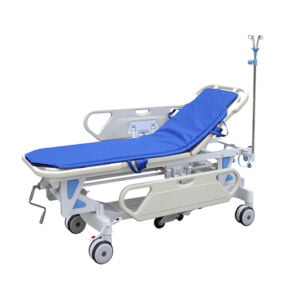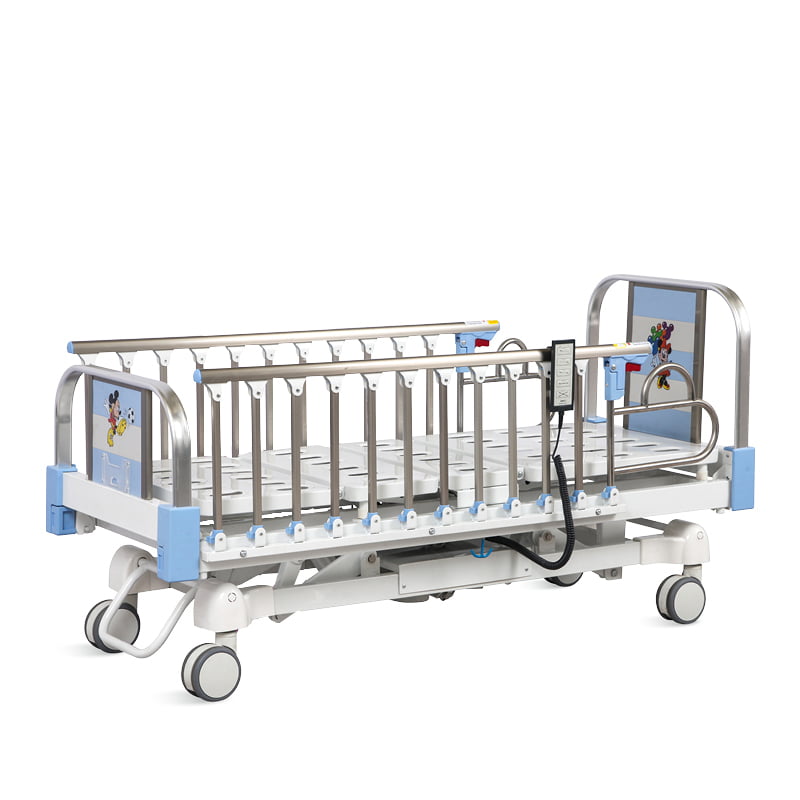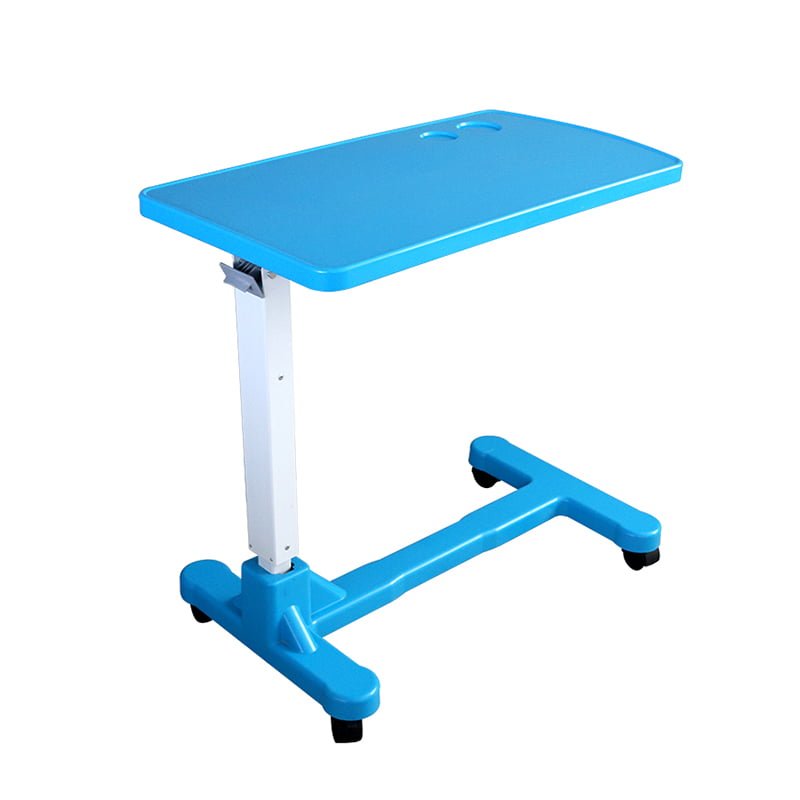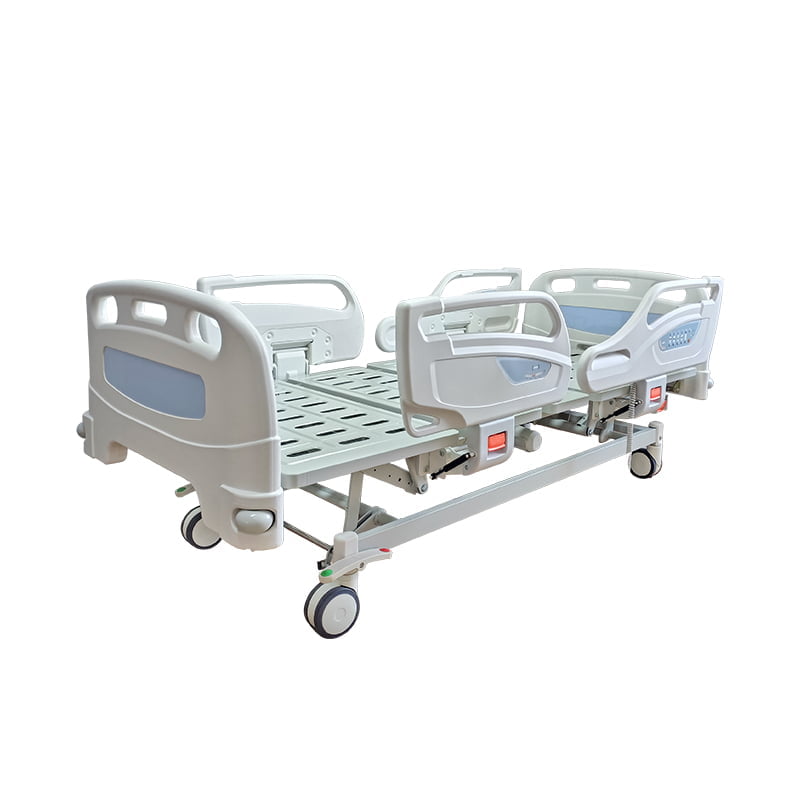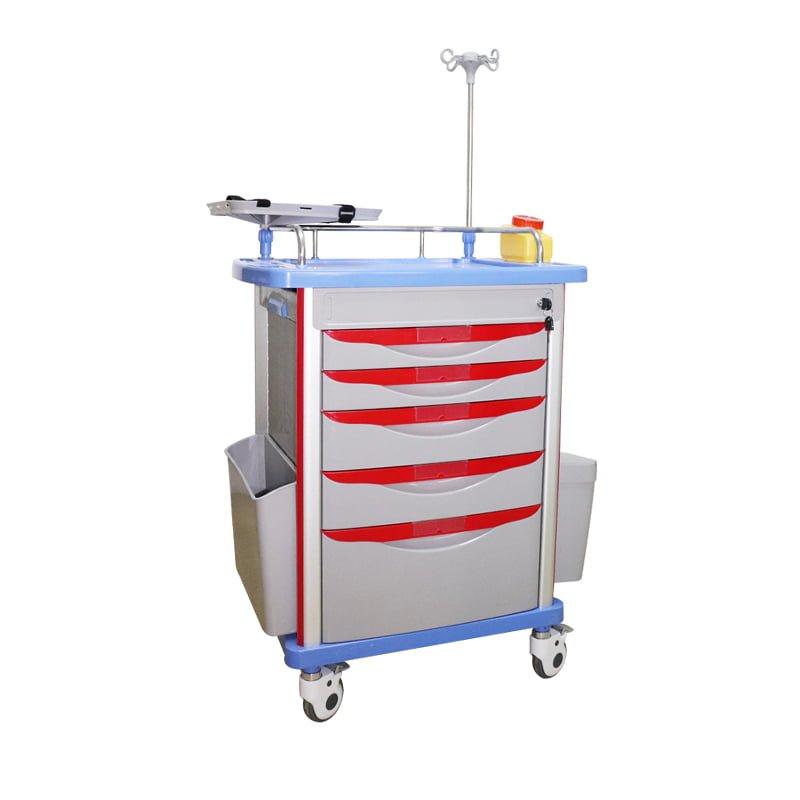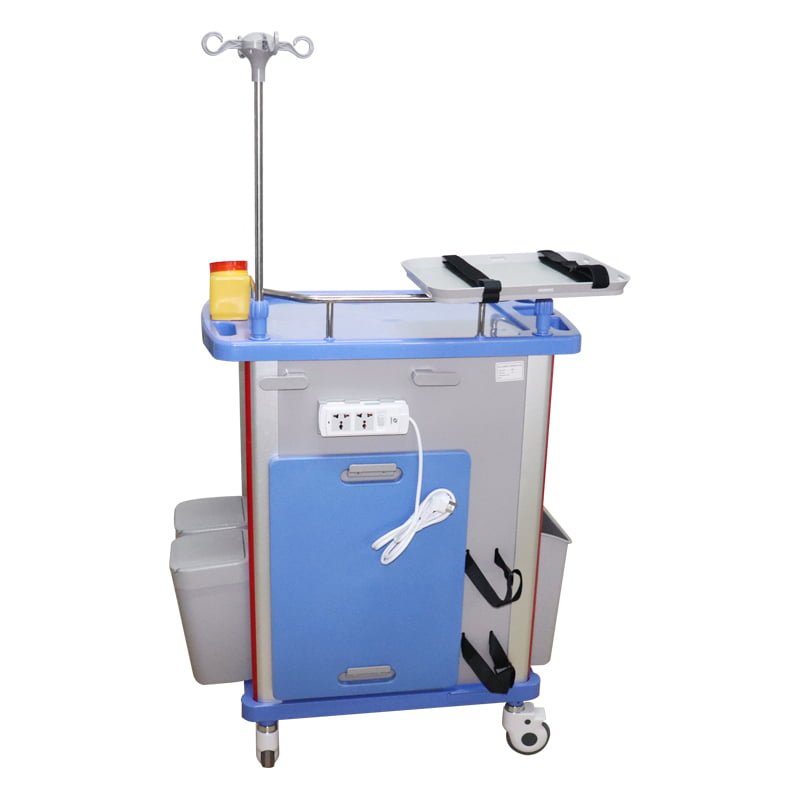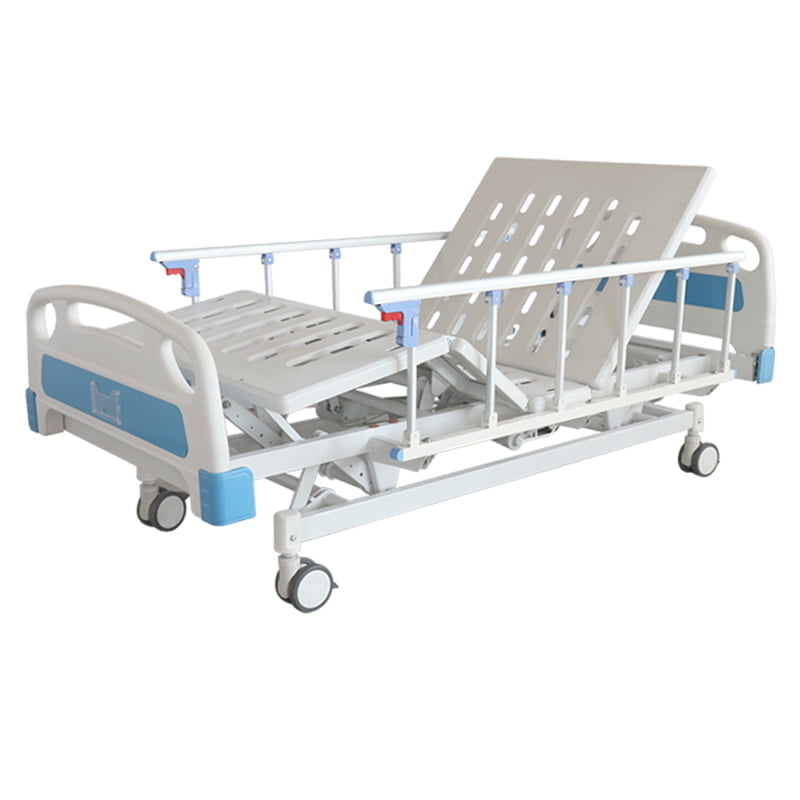ORP-HPT05 Hydraulic Adjustment Hospital Stretcher
A hospital stretcher is a vital piece of equipment for patient care, as it provides comfort, safety and stability for the patient, as well as convenience and efficiency for the medical staff. ORP-HPT05 hydraulic adjustment hospital stretcher is a high-quality model that has wheels, handles, side rails, brakes and a mattress, with additional features such as adjustable height by hydraulic pump and crank. A hospital stretcher can make a difference in the outcome of patient transfer, and can enable fast and smooth access to diagnostic and therapeutic procedures.
Technical Parameter:
| Bed Height Min | 630mm |
| Bed Height Max | 930mm |
| Mattress Platform | 2170*810mm |
| Mattress Thickness | 50mm |
| Safe Working Load | 250kg |
| Back-rest | 80°±10° |
| Knee-rest | 30°±5° |
| Trendelenburg | 15°±5° |
| Reverse Trendelenburg | 15°±5° |
Technical Configuration:
| Hydraulic Pump | 2pcs |
| Crank System | 1set |
| Back Rest Gas Spring | 2pcs |
| 200mm Caster | 4pcs |
| Central Locking Pedal | 2pcs |
| Directional Wheel Release Pedal | 2pcs |
| Directional wheel | 1pc |
| Function Control Pedal | 1set |
| Emergency Push Handle | 1set |
| Foldable Side Rail | 1set |
| IV Pole | 2pcs |
| IV Pole Prevision | 6pcs |
| Oxygen Cylinder Holder | 1set |
| Mattress | 1pc |
Product Introduction:
Quality Control:
- Technology: The design of a hospital stretcher is of utmost importance when it comes to ensuring the safety and well-being of patients. The primary objective of this design is to minimize the risk of infection in the hospital environment. These features make the stretcher equipped with a seamless and smooth bed surface and foot board that meet the highest standards of infection prevention in hospitals. It is easy to clean and disinfect the stretcher surface thoroughly, thereby reducing the spread of germs and bacteria. Additionally, the stretcher is built to be robust and strong, thanks to the use of a 360° no blind spot welding technology. This technology ensures that there are no crevices or fissures in the stretcher frame that could trap bacteria or dirt. As a result, the stretcher can withstand frequent use and provide stability and dependability for patients in need of medical attention.
- Safety Standard: The hospital stretcher adheres to multiple rigorous standards, ensuring its safety and reliability in medical settings. It meets ISO 13485:2016, which is specific to medical devices, indicating that the stretcher is manufactured under a comprehensive quality management system focused on safe medical device design and production. Additionally, it complies with ISO 9001:2015, the widely recognized standard for quality management across various industries, emphasizing customer satisfaction and continuous improvement. The stretcher also holds CE certification, confirming it meets the health, safety, and environmental protection standards required for products sold within the European Economic Area. These certifications make the stretcher a trustworthy choice in healthcare, providing assurance of its quality, safety, and regulatory compliance.
Frameworks:
- Platform: The platform of the hospital stretcher is ingeniously designed to enhance patient care, particularly in diagnostic procedures. It is divided into four distinct sections: the back board, the buttock board, the thigh board, and the calf board, which together provide comprehensive support to the patient while allowing for specific positional adjustments. The entire platform is constructed from X-ray translucent materials, facilitating X-ray examinations without the need to move the patient, thereby increasing comfort and reducing the risk of further injury. This feature is especially valuable in emergency and acute care settings where quick diagnosis is crucial. Additionally, the stretcher is equipped with a hand crank on the side, allowing the operator to control the movement of an X-ray cassette holder located underneath. This enables full-body imaging from various angles, ensuring thorough medical evaluations while maintaining patient stability and safety.
- Foot Board: The foot board of hospital stretcher is a detachable component that can be easily removed and reattached as needed. The foot board is easy to hold, as well as preventing the patient from sliding off the stretcher during transport or treatment. The foot board is made of durable and lightweight materials that are resistant to stains, scratches, and corrosion. The foot board can be securely locked in place with a simple mechanism.
- Side Rail: There are aluminum alloy and stainless steel tilting side rails on hospital stretcher. This side rail is designed to provide safety for the patient during transport and treatment. The side rail can be tilted up or down on the each side of the stretcher. The side rail is also equipped with a locking device to prevent accidental movement or release. The aluminum alloy and stainless steel materials are durable, lightweight, and easy to clean. They also resist corrosion and rust, which are common problems in hospital environments. The aluminum alloy and stainless steel tilting side rail on hospital stretcher is a useful and reliable component that enhances the quality of care and service for the patient.
Functions:
- Hydraulic Pump: The hydraulic pump is an indispensable component which enable efficient power transmission while providing precise control over machinery operations.The hydraulic pump on hospital stretchers provide smooth and controlled movements, ensures that patients can be safely and comfortably transported within healthcare facilities. One of the key benefits of a hydraulic pump on a hospital stretcher is its ability to adjust the height of the stretcher. This feature allows healthcare professionals to easily transfer patients onto different surfaces, such as beds or examination tables, without straining their own backs or risking injury to the patient. In addition to height adjustment, hydraulic pumps also enable smooth and controlled movements when raising or lowering the back-rest or knee-rest of the stretcher. This flexibility is essential for providing optimal patient positioning during medical procedures or when adjusting for individual comfort. Furthermore, hydraulic pumps on hospital stretchers are designed with safety in mind.
The functions controlled by FOOT PEDAL are as below:
- Trendelenburg/Reverse Trendelenburg: The Trendelenburg or Reverse Trendelenburg position is a type of adjustment that a hospital stretcher can make to the patient’s body orientation. Trendelenburg position is when the patient’s head is lower than their feet, while reverse Trendelenburg position is when the patient’s head is higher than their feet. It adjusts the stretcher so that the patient’s head is either below or above the level of the feet, respectively. This adjustment can have various benefits for the patient, such as enhancing blood flow, alleviating edema, or easing respiration. A hospital stretcher can incline the Trendelenburg or Reverse Trendelenburg position up to 15°±5°.
- Whole Stretcher Height Adjustment: The height of the hospital stretcher platform can be adjusted to suit the needs of different situation. The minimum height of the platform is 630mm, which allows for easy transfer of patients from beds or wheelchairs. The maximum height of the platform is 930mm, which enables comfortable examination or treatment of patients without bending or straining, as well as convenient for medical staff, without having to bend over or strain their backs.
The following function is controlled by the HAND CRANK:
- Leg Section Adjustment: The leg section of the hospital stretcher is designed to be adjustable in order to provide support for the patient. The leg section can be raised or lowered by using the crank on the side of the stretcher. The maximum angle that the leg section can reach is 30°, with a tolerance of plus or minus 5°. This angle is optimal for preventing blood pooling and reducing pressure on the lower back. The leg section should not be adjusted beyond this limit, as it may cause injury or damage to the stretcher mechanism.
The following function is controlled by the HANDLE:
- Back Section Adjustment: The back section of the hospital stretcher features an adjustable mechanism designed for enhanced patient comfort and versatility in medical care. This adjustment is made possible through a lever located beneath the back board. By pressing and lifting this handle, the back section can be raised to the desired position, facilitating various medical procedures and patient needs. The back can be inclined up to 80°±10°, providing a substantial range of motion that can support patients in a seated or semi-reclined posture. This functionality is particularly beneficial during patient assessment, treatment, or when patients need to be positioned upright for comfort or specific clinical requirements. The ease of adjustment ensures that caregivers can quickly adapt the stretcher to meet the immediate needs of the patient, enhancing both the efficiency of medical care and the patient’s experience.
Accessories Details:
- Caster with Central Locking: The castors measuring at 200mm, offer a seamless experience for both patients and medical professionals. The castors have central locking pedal. With just a simple press down on the pedal, the entire stretcher can be securely locked in place. This not only ensures stability during patient transfers but also provides peace of mind for healthcare providers. The castors are designed to be quiet, minimizing unnecessary noise that can disrupt patient comfort and recovery. The anti-winding feature prevents any tangling or obstruction while moving, ensuring smooth navigation throughout hospital corridors. Moreover, these castors are built to withstand heavy usage and wear over time, they are corrosion-resistant. The castors with central locking pedal enhancing maneuverability, safety, and durability of hospital stretcher. Medical professionals can now navigate through busy hallways effortlessly while maintaining control over patient transportation.
- Directional Wheel with Control Pedal: A directional wheel with a control pedal on a hospital stretcher allows healthcare professionals to maneuver the stretcher more easily and efficiently. This type of system would provide better control and maneuverability, especially in tight spaces or when navigating corners. With directional wheels and control feet, hospital stretchers can take different actions according to different needs. When the green side of the pedal is pressed down, the entire stretcher can turn to adapt to the curve. When the red side of the pedal is pressed down, the stretcher can only go straight, suitable for smooth and long channel transport over long distances. The foot pedal is convenient for medical staff, saves time and effort, and can meet the transportation needs of the hospital. It could reduce the physical strain on healthcare professionals when moving patients, as well as improve the overall safety and comfort of patients during transport.The wheel and control pedal would provide more precise control, allowing for smoother and more movements.
- IV Pole: The infusion pole is made of stainless steel and has four hooks to hang the infusion bags. The height of the pole can be adjusted according to the needs of the patient and the nurse. The pole can support up to 15kg of weight and is very sturdy. To use the infusion pole, first lift it up and insert it into the holder that is located at the foot of the stretcher. Make sure it is securely fixed and then hang the infusion bags on the hooks. If not needed, first lower its height and then pull it out of the holder. You can fold and lie the pole down, place it on the stretcher platform when it is not in use.
- Emergency Push Handle: An emergency push handle is a common feature found on hospital stretchers. It is a handle located at the head end of the stretcher. The purpose of this handle is to provide healthcare professionals with a quick and convenient way to push or maneuver the stretcher during emergency situations. During emergencies, time is of the essence, and the ability to swiftly and easily move the stretcher can be crucial. The emergency push handle allows healthcare professionals to exert force and guide the stretcher in a rapid and controlled manner. In addition to emergency situations, the push handle can also be utilized during regular patient transport, especially when navigating through tight spaces or crowded areas. It provides an additional point of contact for pushing the stretcher, making it easier for healthcare professionals to maneuver the stretcher smoothly and safely.
- Oxygen Cylinder Holder: An oxygen cylinder holder is a common feature on hospital stretchers that allows for the secure placement and transportation of oxygen bottles. ORP-HPT05 oxygen cylinder holder consist of two plastic circles with a rotary plug to hold the oxygen bottle. The oxygen cylinder holder helps prevent the bottle from accidentally falling or being tipped over.The two circles are designed to hold the oxygen cylinder in place. They have a gripping mechanism or be adjustable to accommodate different sizes of oxygen cylinder, it is a mechanism that allows for easy insertion and removal of the oxygen cylinder . It may rotate or have a locking mechanism to secure the cylinder in place during transport.
- Mattress: The hospital stretcher mattress with a thickness of 50mm can provide adequate comfort and support for patients during transport or rest on the stretcher. The mattress is waterproof and corrosion resistant, it helps to protect the mattress from spills, bodily fluids, and other liquid-related incidents, ensures easier maintenance and hygiene. Longevity and durability, particularly in environments where cleaning agents and disinfectants might be used regularly. The mattress is also soft to provide comfort to patients.
CASTOR
Diameter 6″ castor with central brake system is excellent for transportation.
FOOT BOARD
Removable bed end with safety lock solid and durable.
HYDRAULIC SYSTEM
The stretcher body is equipped with two independent hydraulic cylinders to support bed surface lifting and position use
FOLDABLE IV POLE
The infusion pole is fixed at the corner of the stretcher and is made of stainless steel with four hooks. The height can be adjusted. The pole can fold and lie down to the platform if not needed.Bearing capacity 15kg.
FOOT PEDAL
Height adjustment, Trendelenburg and Reverse Trendelenburg functions are controlled by the foot pedals, which and release the hands of the user.
PUSH HANDLES
Bed head end equiped with a set of foldable pushhandles, which is convient for user.
METAL GUARDRAIL
Equipped with aluminum alloy and stainless steel tilting guardrail, robot welding, 360° full smooth surface.




